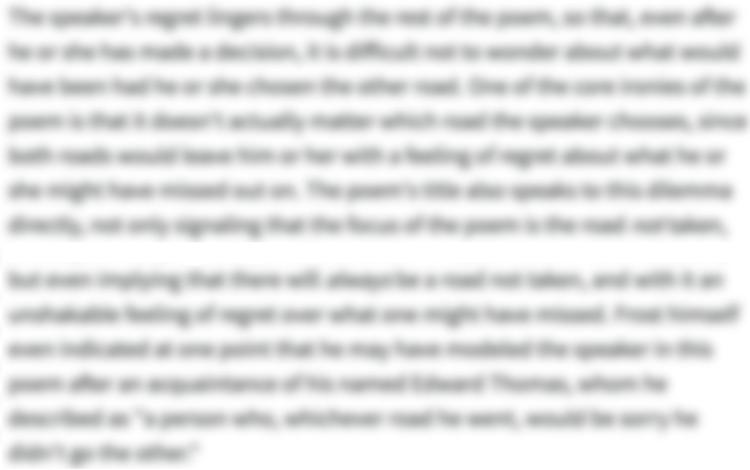The Full Text of “The Emperor of Ice-Cream”
1Call the roller of big cigars,
2The muscular one, and bid him whip
3In kitchen cups concupiscent curds.
4Let the wenches dawdle in such dress
5As they are used to wear, and let the boys
6Bring flowers in last month's newspapers.
7Let be be finale of seem.
8The only emperor is the emperor of ice-cream.
9Take from the dresser of deal,
10Lacking the three glass knobs, that sheet
11On which she embroidered fantails once
12And spread it so as to cover her face.
13If her horny feet protrude, they come
14To show how cold she is, and dumb.
15Let the lamp affix its beam.
16The only emperor is the emperor of ice-cream.
-
“The Emperor of Ice-Cream” Introduction
-
"The Emperor of Ice-Cream" is one of the most well-known poems by American Modernist poet Wallace Stevens. The poem appears in Stevens's widely influential debut collection, Harmonium, which was published in 1923. The meaning of the poem is notoriously ambiguous, but its two equal-length stanzas present clear enough scenarios. An old woman has died, and in the first stanza the speaker issues instructions to others for the funeral or wake. In the second stanza, the speaker appears to be in a quieter room with the woman's cold, dead body. Here, the speaker seems to issue a mysterious plea for reality to be stripped of illusory appearances. Readers have often interpreted the poem as showing the ultimate triumph of life over the silence of death. This isn't necessarily some heroic victory, but rather a wider point about the nature of experience.
-
-
“The Emperor of Ice-Cream” Summary
-
Bring in the big strong man who makes cigars, and tell him to get to work making ice cream from lusty curds of milk. Tell the women they can wear whatever they normally wear, and tell the boys to bring flowers wrapped up in old newspaper. Let reality triumph over illusion. There's only one real emperor: the emperor of ice cream.
Inside a drawer of the pine dresser (which is missing three of its glass knobs) you'll find a bedsheet belonging to the dead woman, one which she herself stitched with elaborate patterns. Lay it over her body and make sure her face is covered. If her feet (with their bunions and toes like horns) stick out at the bottom, it's just to remind us that she's cold and dead. Fix the lamplight on her in full glare. There's only one real emperor—the emperor of ice cream.
-
-
“The Emperor of Ice-Cream” Themes
-
Reality vs. Appearances
“The Emperor of Ice Cream” is one of Wallace Stevens’s most famous and most notoriously ambiguous poems. It’s hard to pin down the poem’s themes precisely—indeed, that’s probably deliberate on Stevens’s part—but the poem definitely presents a juxtaposition between the way things appear to be and the way things actually are. The mysterious speaker of the poem seems to construct an argument in favor of acknowledging reality—including the finality of death—over being deceived by illusory appearances.
The poem takes place at a wake or funeral, with preparations taking place in what appears to be someone's home. The first stanza is about making these ritualistic preparations for the ceremony, while the second stanza discusses how to handle the dead body (revealed to be that of an old woman). In both sections, the speaker fixates on the contrast between “being” and “seeming”—between reality and appearances.
For example, the speaker tells the “wenches” to put on the “dress […] they are used to wear.” The word “wenches” might refer female servants, prostitutes, or simply girls; in any case, these are implied to be working-class women whose typical “dress” wouldn't be fancy. Flowers, meanwhile, should be brought wrapped in “last month’s newspapers.”
These two instructions perhaps reflect the speaker’s wish to strip any illusory appearances from reality. That is, the women shouldn’t dress in a way that is somehow different, and the flowers similarly don’t require fancy ribbons or wrapping paper. In fact, the flowers’ covering might even be thought of as actually capturing reality, as the newspapers report actual events. The poem suggests that there’s no real benefit to dressing things up to seem better than they are—especially in the face of death (again, this all takes place at a wake or funeral of some sort).
This idea is strengthened by the last two lines of the first stanza: “Let be be finale of seem. / The only emperor is the emperor of ice cream.” The first of these two lines addresses this theme head on: let “be” (how things actually are) “be" the "finale” (the ending) of “seem” (false appearances). In other words, let reality dispel the magic of illusions. Perhaps this relates to death, with the speaker expressing the way that death, as life’s only real certainty, strips away any world of appearances that people might construct for themselves during their earthly lives.
The repeated line about the “emperor of ice cream” also seems to strengthen this reading. An “emperor of ice-cream” is a kind of oxymoron: emperors are supposed to be mighty, powerful figures, meaning that being an emperor of ice-cream sounds like a kind of joke title. This might be similar to the fable of the emperor’s new clothes, suggesting that power is itself a kind of illusion (and therefore an appearance that needs to be replaced by reality).
The speaker’s instructions for the handling of the dead body also contribute to this implicit argument against illusory appearances. Though the speaker wants the body to be covered with “embroidered fantails” (a decorative sheet) as a kind of tribute to the woman, it doesn’t matter whether it fully covers her. If her feet poke out, then so be it; they are simply a reflection of the stark reality that this woman is “cold,” dead, and “dumb.”
Accordingly, the “lamp” should “affix its beam”—it should cast an unflinching light on reality for all to see. And as if to underscore this point, the poem then repeats its key line: “The only emperor is the emperor of ice-cream.” People shouldn’t put so much emphasis on appearances, the poem suggests, and should instead embrace the reality of life, death, and who they are.
- See where this theme is active in the poem.
-
Life, Death, and Sensuality
Though it’s not spelled out explicitly, “The Emperor of Ice Cream” appears to suggest that life is fleeting and, because of that, precious. The poem often focuses on life's sensuality—the experience and pleasure of the world as known through the senses, such as taste. It opposes that sensuality to the “cold” and numbness of death. In doing so, it gently nudges its readers to contemplate this opposition. That is, the poem seems to argue for the importance of living life to its fullest, because death is inevitable. Savoring joy and pleasure—eating that delicious “ice-cream”—is thus all that really matters.
The poem takes place at a wake (an obvious representation of death) but everything about the speaker’s instructions for the wake celebrates the sensuous pleasures of being alive. In particular, the poem’s focus on ice cream foregrounds the importance of sensory enjoyment. Indeed, the first instruction issued by the speaker is to fetch a strong cigar-maker—“the muscular one.” The mention of the man's muscles has sexual undertones, which is likewise supported by the presence of “wenches,” a sexually loaded and archaic term for women. In this way, then, the kitchen scene of the poem is subtly governed by the presence of sensual and sexual pleasure.
Yet this pleasure won't last forever. After all, cigars burn out, ice cream melts. Like sex, these suggest a fleeting, precious kind of enjoyment. Ironically, the dead body in the poem does the opposite of ice cream, easily becoming cold. Ice cream, then, is a complicated symbol. On one hand, it speaks to life's sensual pleasure. On the other hand, in linking with the "cold" dead body, it represents the knowledge of inevitable death, which creates the need to embrace sensuality in the first place.
The speaker’s other instructions also link sensuality with the vividness of life. The image of “flowers in last month’s newspapers” contrasts symbols of life's briefness and beauty—flowers—with the discarded waste of the past: newspapers. Again, this can be read as a subtle argument in favor of valuing life through the enjoyment of the senses. In other words, it’s worth stopping to smell the flowers, since time inevitably marches forward and everything will eventually become old news.
This idea also applies to the use of the specific bedsheet for covering the body. The dead woman, when she was alive, once engaged in a kind of sensory pleasure: the embroidery of beautiful patterning (“fantails”). This embroidery was an aesthetic pursuit not necessary to the cloth itself. Mentioning the embroidery acknowledges the worth of this kind of human activity, which is motivated by beauty rather than just survival.
Additionally, one of the most engaging aspects of the poem is its beautiful use of sound patterning through consonance, assonance, and alliteration. This is established right from the beginning, as the mysterious speaker begins the instructions for the servants. The /l/ consonance in the first line, the /i/ assonance in lines 2-3, and many other examples throughout the poem are in themselves sensuous events, pleasing to the reader’s ear. These sounds help build a vivid picture of a scene alive with sensuality.
In this reading, then, the "emperor" of the poem’s title doesn't necessarily have anything to do with power and authority in the usual sense. This isn't a real emperor, perhaps, but a personification of the love of sensuous beauty and pleasure, of celebrating life in all its fleeting glory. The speaker states emphatically that all other emperors pale in comparison to the "emperor of ice cream." No amount of power, the poem suggests, can compare to the power of one's own senses.
- See where this theme is active in the poem.
-
-
Line-by-Line Explanation & Analysis of “The Emperor of Ice-Cream”
-
Lines 1-3
Call the roller of big cigars,
The muscular one, and bid him whip
In kitchen cups concupiscent curds."The Emperor of Ice Cream" opens by immediately establishing its imperative voice—the speaker's instructions using present-tense verbs like "Call," "bid," "Let," and so on. This gives the poem a ceremonial atmosphere right from the start, the speaker taking on the role of organizer for some kind of ritual (which gradually reveals itself to be a funeral or wake). The first instruction, then, is issued in lines 1-3. Here, the speaker summons the "roller of big cigars" (a "muscular" man). He then says that the man should be instructed ("bid him") to start making ice cream ("concupiscent curds") for the funeral/wake.
Even just in the space of three lines, the poem introduces a number of its key features, in addition to the imperative voice. One of the poem's major themes is finding a kind of aesthetic pleasure in everyday experience, and the poem's language is tuned precisely to make the poem itself, in its way, delicious. So the first line goes straight in with prominent consonance and a little assonance, while lines 2 and 3 add alliteration and much more consonance and assonance too. This involves /l/, /g/, /r/, /k/, /p/, /n/, /s/, and short /i/ sounds
Call the roller of big cigars,
The muscular one, and bid him whip
In kitchen cups concupiscent curds.Stevens's poetry often delights in the sound of language, and the poem is just as concerned with this kind of pursuit as it is with any literal meaning. This amounts to a performance of sensuality—after all, even a funeral is a kind of show.
"[C]oncupiscent curds" is Stevens's deliberately gaudy way of saying ice cream, which is one of the poem's main symbols. The word "concupiscent" relates to sexual desire, which also ties in with the innuendo of "big cigars" (hinting at male genitalia). And "curds" are coagulated bits of milk used in cheesemaking. Here, they're meant to poetically suggest the thick sensuousness of ice cream. Additionally, while ice cream is cold to the touch—like the dead woman's body—it also symbolizes a kind of revelry in the senses, with its sweet and thrillingly cold taste. It also—like life—doesn't tend to last that long!
These links aren't intended to be explicit, but instead hum away in the background of the poem as the reader makes their way from line to line. Stevens himself thought the point of this poem was to make people conscious of "the excitement of reality"—and there's definitely something visceral and exciting about the way these three lines begin.
-
Lines 4-6
Let the wenches dawdle in such dress
As they are used to wear, and let the boys
Bring flowers in last month's newspapers.

Unlock all 353 words of this analysis of Lines 4-6 of “The Emperor of Ice-Cream,” and get the Line-by-Line Analysis for every poem we cover.
Plus so much more...
Get LitCharts A+ -
Lines 7-8
Let be be finale of seem.
The only emperor is the emperor of ice-cream. -
Lines 9-12
Take from the dresser of deal,
Lacking the three glass knobs, that sheet
On which she embroidered fantails once
And spread it so as to cover her face. -
Lines 13-14
If her horny feet protrude, they come
To show how cold she is, and dumb. -
Lines 15-16
Let the lamp affix its beam.
The only emperor is the emperor of ice-cream.
-
-
“The Emperor of Ice-Cream” Symbols
-
Ice Cream
Ice cream is, of course, at the heart of this poem. Roughly speaking, it symbolizes the sensual pleasures of life.
The poem opens with the mysterious speaker issuing an instruction to fetch the "muscular" man who has the strength required to make the ice cream. It's possible that the poem is situated in—or inspired by—Stevens's numerous business trips to Florida. There are stories which are hard to verify—though they were even put forward by Stevens's friend and fellow poet Elizabeth Bishop—that ice cream was traditionally served at funerals in Key West.
But the truth—or lack of it—about the presence of ice cream at funerals is not really relevant to the reader's experience of the poem. This funeral/wake does feature ice cream, and throughout the poem ice cream is imbued with a sense of symbolic importance. Ice cream is a strong and sensuous experience, its sweetness and coldness generally viewed as something pleasurable. In this sense, then, ice cream seems to encapsulate the poem's subtle argument about being alive—living is all there is, and then you die, so you might as well fully engage with what you experience. Ice cream also represents the fleeting nature of life in the sense that it easily melts away if left out at room temperature.
It's also worth thinking about why Stevens uses the curious phrase "emperor of ice-cream." Ultimately, the poem seems to be suggesting that power—and indeed, everything people tell themselves about who they are—is a kind of fiction. The only reality is what people experience in life, and so ultimately lived experience—the pulse and glow of day-to-day life—is the only real authority.
- See where this symbol appears in the poem.
-
Clothes and Sheets
In both stanzas of "The Emperor of Ice Cream" there is a mention of clothing or covering. In both instances, the speaker emphasizes the modesty of these garments, which symbolize life as it is, as opposed to illusions people might have about life.
That's why, then, the mysterious speaker issues the instruction for the young women ("wenches") to wear what they usually wear. Let them be as they are, in other words—they don't need to pretend to be something else just for the sake of this funeral. Likewise, the dead woman's body should be covered—but if the sheet isn't long enough to stop her "horny feet" from sticking out, it really doesn't matter. Her cold, dead-still feet demonstrate a key part of life and reality: death. There's no point trying to cover up the fact that everyone is going to die. Interestingly, then, acceptance of death becomes a kind of way to embrace life.
- See where this symbol appears in the poem.
-
Flowers in Newspaper
In the poem, flowers symbolize the beauty and briefness of life. Meanwhile, the old newspapers they're wrapped in symbolize all that's illusory about the human world. The poem doesn't dwell on the flowers for very long, but it's worth noting just how specific the speaker's instructions about them really are. Presumably, the flowers are a necessary part of the funeral/wake—a common way to mark respect for the dead. But the speaker specifically asks for them to be brought in "last month's newspapers." This image, then, contrasts brief and beautiful symbols of life—flowers—with the discarded waste of the past—newspapers.
Overall, the poem argues that death is a certainty, which means that what's most real about life is sensual experience. Things like power and authority are fictions (one of Stevens's favorite words to describe how humans interpret the world). So, embracing everyday lived experience is a kind of way to embrace the only reality that there actually is—the senses.
Following this logic, the literal old news that wraps the flowers symbolizes the illusory side of life—the pretension that there is anything other than what is actually experienced on a day-to-day, immediate level. All those things that probably seemed so important a month ago are now just mere wrapping paper for the thing that really is important: vivid, vibrant, pulsating, fleeting life in form of the flowers.
- See where this symbol appears in the poem.
-
-
“The Emperor of Ice-Cream” Poetic Devices & Figurative Language
-
Alliteration
Alliteration is a major feature of "The Emperor of Ice Cream." Its main function overall is to bring out the beauty of everyday things, which helps make the poem's case in favor of the sensuousness of daily life.
Though "big" and "bid" across lines 1 and 2 chime together alliteratively, the first main example is in line 3:
In kitchen cups concupiscent curds.
There's nothing subtle about the alliteration here. It exerts great force on the line, relating to the "muscular" man who comes to make the ice cream. It is deliberately what Stevens would call "gaudy," what modern day readers might think of as tacky and extravagant. It's as though the line takes delight in its own sound, subtly reinforcing the poem's point about the vitality of everyday experience. This alliteration also captures the repetitive work of churning ice cream.
In line 4, "dawdle" and "dress" alliterate to suggest decadence and, in the way that the two words are separated by two intervening words, the slowness of dawdling. These moments, and even the mention of the "boys" who "bring" flowers, all have sexual undertones that are in part aided by the alliterative sound. The poem seems to draw a link between being alive and the possibility of sexual, or "concupiscent," encounters.
In line 9, "dresser of deal" suggests how the poem's interest in beautification applies even to humble objects. This "dresser" is made of "deal," or cheap pine wood, yet even this modest, utilitarian object is shown to be beautiful through the speaker's use of alliteration. The device captures how people's senses give them access to the beauty of ordinary things.
Meanwhile, the /l/ alliteration in line 15 between "let" and "lamp" seems to be more about fixing the line with particular sounds, like an image coming into sharper focus (in this case, the poem's image of a dead woman). Here, alliteration shows how—for all the poem's gaudiness—it is also incredibly precise.
- See where this poetic device appears in the poem.
-
Assonance


Unlock all 291 words of this analysis of Assonance in “The Emperor of Ice-Cream,” and get the poetic device analyses for every poem we cover.
Plus so much more...
Get LitCharts A+ -
Allusion
-
Caesura
-
Consonance
-
End-Stopped Line
-
Repetition
-
Personification
-
-
“The Emperor of Ice-Cream” Vocabulary
Select any word below to get its definition in the context of the poem. The words are listed in the order in which they appear in the poem.
- Bid
- Concupiscent
- Curds
- Wenches
- Dawdle
- Finale
- Dresser
- Deal
- Embroidered
- Fantails
- Horny Feet
- Protrude
- Dumb
- Affix
Bid-
Tell, ask, command.
- See where this vocabulary word appears in the poem.
-
Form, Meter, & Rhyme Scheme of “The Emperor of Ice-Cream”
-
Form
"The Emperor of Ice-cream" is composed of two equal-length stanzas. Each stanza has eight lines, a form known as an octave or octet. This form is an important aspect of the poem, dividing the speaker's and reader's experience neatly into two. The word "stanza" can also mean "room"—and Stevens definitely plays on this meaning by having two distinct interiors in each stanza. Additionally, lines 7 and 8 and the final two lines act as a kind of refrain, with lines 8 and 16 repeating exactly, and lines 7 and 15 both starting with "Let" and ending on a rhyme with "ice-cream."
The first room or stanza seems to be a kitchen in which frantic preparations for the wake are taking place. The speaker orchestrates these preparations, and in general the first stanza seems full of vibrant, unfiltered life. Line 7-8 are a little different from the rest of the first stanza, essentially summing up the speaker's observations and thoughts in abstract terms. There is a logical leap from the muscular cigar maker, the wenches, and the boys to the speaker's mysterious proclamations:
Let be be finale of seem.
The only emperor is the emperor of ice-cream.Of course, it's up to the reader to decide how these two lines relate to what's come before.
The second stanza uses a similar set-up, and seems to take place in the woman's bedroom. Lines 9-14 deal in concrete details, and lines 15-16 offer a kind of summary or commentary. This stanza—or room—is much quieter, and is full of death rather than life. Both stanzas, however, lead the speaker to the same conclusion—that "The only emperor is the emperor of ice-cream."
-
Meter
"The Emperor of Ice-Cream" is written in a very loose iambic tetrameter (four stresses in a da-DUM pattern), with most lines offering some kind of variation. Additionally, the final two lines of each stanza deviate from this meter, employing trimeter (three stresses) fellowed by hexameter or heptameter (six or seven stresses). Generally speaking, the poem's meter is often off-kilter, so that the poem by turns reads as exuberant, uneasy, or sober.
There are a few specific instances of particular note. For example, look at the clunky array of stresses in lines 2 and 3, and how they suggest the "muscular[ity]" of the man who "whip[s]" the ice-cream:
The mus- | cular one, | and bid | him whip
In kit- | chen cups | concu | piscent | curds.The poem substitutes an anapest (da-da-DUM) for an iamb in line 2, and then in the next line introduces an extra stress—including two stresses right next to each other. Coupled with the line's /k/ consonance and alliteration, these lines are a mouthful. They're almost exhausting to read! This suggests the physical exertion required to make the ice cream.
As these examples show, the poem isn't afraid to deviate considerably from its meter. Some lines have five stresses, such as line 5, which is a straightforward example of iambic pentameter (five stresses a line). Line 9, meanwhile has three stresses composed of looping dactyls (DUM-da-da):
Take from the | dresser of | deal,
Lines like these are very attentive to rhythm, while they also refuse to conform to the monotony of a steady meter.
The truest line of iambic tetrameter comes in line 14:
To show | how cold | she is, | and dumb.
Steady iambs can sometimes sound quite solemn, and that seems to be the deliberate effect here. This is the poem's starkest moment, its clearest confrontation with the reality of death. The tone of the steady iambs seems fitting, perhaps hinting at the steadiness of a funeral march, or the slow, synchronized steps of coffin-bearers.
Additionally, each stanza's second-to-last line is written in trimeter rather than tetrameter, containing one less stress. Here are lines 7 and 15:
Let be | be fina- | le of seem.
Let | the lamp | affix | its beam.
As can be seen, these two lines continue to play fast and loose with iambs. Line 7, for instance, employs two anapests. What both lines have in common, though, is that they suddenly cut short the poem's momentum. Because they are end-stopped and have one less syllable, they have a certain starkness to them, as well as an assertiveness. They pithily argue for the direct confrontation of reality.
Finally, a word must be said about the poem's refrain:
The on- | ly em- | peror | is the em- | peror | of ice-cream.
At six stresses (hexameter), the line is obviously longer than any of the poem's other lines. Three iambs are followed by an anapest, another iamb, and an amphibrach (da-DUM-da).
Alternatively, this line could be read as stressing the word "is":
The on- | ly em- | peror | is the | emper- | or of | ice-cream.
This bumps the line up to seven syllables (heptameter)—creating a pattern in which iambs are replaced halfway through the line with trochees. Such a reading also emphasizes the word "is." Doing so harkens back to the speaker's injunction, "Let be be finale of seem." Placing a stress on this present-tense form of the verb "to be" once again captures the speaker's interest in living in the present.
However one interprets this final line, its surprising length and distinctive rhythm add to its cryptic tone, providing a satisfying ending to this striking poem.
-
Rhyme Scheme
There is no real rhyme scheme to speak of in "The Emperor of Ice Cream." The poem does have some instances of rhyme, however. These occur in lines 7 and 8, 13 and 14, and 15 and 16. As a result, each stanza ends with a rhyming couplet.
Lines 13 and 14 use their rhyming pair—"come" and "dumb"—to show the silence of the dead woman, her sheer deadness. Both words are soft-sounding, evoking the quietness of the room in which her body lays at rest.
Meanwhile, lines 7, 8, 15 and 16 all use the same rhyme, with the /eem/ sound. These rhymes give these particular statements extra weight and authority. This makes sense given that these lines essentially offer the speaker's final thoughts and instructions for each stanza. So lines 7 and 8 comment on the hustle and bustle of the first stanza's kitchen scene, while lines 15 and 16 refer to the dead woman.
There's a logic to these four lines taken in isolation. Let "being," or reality, be the end of "seem," or false appearances. Life and everyday sensation—"the emperor of ice-cream"—is all there is. People should accept this, and acknowledge the reality of death too: "Let the lamp affix its beam." The poem then reiterates its main point in the last line (stated, of course, in the same elusive and mysterious terms). The rhyming words link all of these lines together, creating a logical chain between them. Additionally, by employing rhyme, especially words that rhyme with "ice-cream," the speaker emphasizes the sumptuousness of language, creating a surface that readers can take pleasure in, just as they should take pleasure in their immediate senses.
-
-
“The Emperor of Ice-Cream” Speaker
-
The question of the speaker is one of the most mysterious aspects of "The Emperor of Ice-Cream." The poem has a very weird tone, but it's fairly easy to ascertain what is going on (or appears to be going on). The speaker is helping with the preparations of a funeral or wake, and appears to be an authority on what happens. Accordingly, the poem pretty much consists of the speaker barking instructions at those around—with some more abstract instructions too (lines 7 and 15) that don't seem to really refer to any particular people.
The speaker seems to be concerned with both the practical requirements of the occasion and the philosophical implications of what's being witnessed. The speaker uses imperative verbs throughout—"Call," "Let," "Bring" and so on—which indicate that the speaker is, for one reason or another, in charge.
There's also something particularly Shakespearean about the speaker's tone. This could almost be a soliloquy from one of Shakespeare's plays, which are often full of similar uses of imperatives and unusual grammar—grammar that's almost gymnastic in the way that it bends and plays with the sense of the sentences. Of course, the probable allusion to Hamlet supports this theory too (see Poetic Devices)!
-
-
“The Emperor of Ice-Cream” Setting
-
"The Emperor of Ice-Cream" never specifies its setting, but it appears to be some kind of funeral or wake. In particular, the poem looks at the initial preparations for the ceremony—with the speaker barking orders at others in an attempt to get the whole thing organized.
The first scene is full of life and somewhat chaotic. It appears to be in the kitchen, a kind of behind-the-scenes tour of the funeral preparations. Though some critics have suggested that the presence of cigars and ice cream link the poem to Florida or Cuba, it's impossible to say for sure (though Elizabeth Bishop herself suggested that ice cream was common at funerals in Key West!).
The second scene appears to be in a different room, perhaps the dead woman's bedroom. (It's worth remembering that one of the original meanings of "stanza" is "room.") This stanza is quieter and more contemplative, the hushed silence of the dead woman's room contrasting with the hustle and bustle of the kitchen.
-
-
Literary and Historical Context of “The Emperor of Ice-Cream”
Literary Context
Wallace Stevens is one of the greatest American poets of the 20th century, whom literary critic Harold Bloom called the "best and most representative" American writer of the era. He is generally considered part of the Modernist tradition, though his output is so singular that it doesn't really fit in with other Modernist figures like Ezra Pound and T.S. Eliot.
Instead, Stevens is often linked with Romantic writers like William Wordsworth, Percy Bysshe Shelley, and Ralph Waldo Emerson. Although Stevens lived almost a century after these writers, he shares many of their concerns, most particularly the belief that each individual's imagination shapes their experience of the world. Like these writers, Stevens was interested in using poetry not only to exercise his imagination, but also to think through his ideas. In this lineage, Stevens also shares affinities with his contemporary Hart Crane, another Modernist poet with Romantic leanings.
"The Emperor of Ice-Cream," one of Stevens's most famous and enduring poems, was published in his debut collection Harmonium (1923). This collection was not an instant success, but is nowadays considered one of the most important and widely influential of all English-language poetry books published in the 20th century. Looking at that collection is particularly informative for understanding how such a strangely bizarre and wonderful poem could come to be. The imperative voice (the use of instructional verbs like "call" and "bid" etc.) can be found in numerous poems in the collection. "A High-Toned Old Christian Woman" is one other example among many.
Elsewhere in the collection there are numerous allusions to Shakespeare (supporting the idea that the poem's titular line alludes to Hamlet), and mentions of embroidery and dresses. In its subtle contemplation of the meaning of life and death, "The Emperor of Ice-Cream" also compares well with the perhaps equally famous "The Snow Man."
Many readers are understandably perplexed by this poem, so it's important to also know a little bit about Stevens's general philosophy about poetry. For Stevens, especially at this phase of his writing life, poetry wasn't really something that people had to "get" or "make sense of"—the experience of reading the poem mattered as much as the meaning of the poem. It's worth checking out Stevens's ars poetica (poem about the art of poetry), "Of Modern Poetry," for more of his philosophy.
Historical Context
One of the notable things about "The Emperor of Ice-Cream" is that it doesn't really have much of an historical context. The poem was published in Stevens's 1923 collection, Harmonium, so in terms of major world events it falls between the two world wars. But part of the power of Stevens's poetry is that it doesn't really seem all that concerned with the context in which it was written—it prefers to construct a world of its own.
Stevens famously worked as insurance executive for most of his life, writing poetry by night. He lived a quiet suburban life in Connecticut, apart from frequent trips to Florida, a state he greatly loved. The contemplative reveries of Stevens's poetry, and the way his poems seem to have their own world, has often been linked to the fact that he was able to live a life of quiet prosperity, away from many of the tumultuous events of his time.
There are numerous theories about this particular poem's context. Some people believe that the poem is based on Stevens's experiences in Florida, where he often travelled for business. His fellow poet Elizabeth Bishop asserted that ice cream was a regular part of funerals in Key West, Florida, but this is hard to verify. The presence of cigars in the poem also suggests a link with Cuba.
-
More “The Emperor of Ice-Cream” Resources
-
External Resources
-
More Stevens Poems and Information — A bountiful resource from the Poetry Foundation, including podcasts, essays, and more poems all relating to Stevens.
-
Bloom on Stevens — Audio of a fascinating lecture on Stevens by Harold Bloom, one of the most influential literary critics of the 20th century.
-
A Reading — The poem read by YouTube Tom O'Bedlam.
-
The Thrilling Mind of Wallace Stevens — An interesting article about Stevens's life and work.
-
-
LitCharts on Other Poems by Wallace Stevens
-













